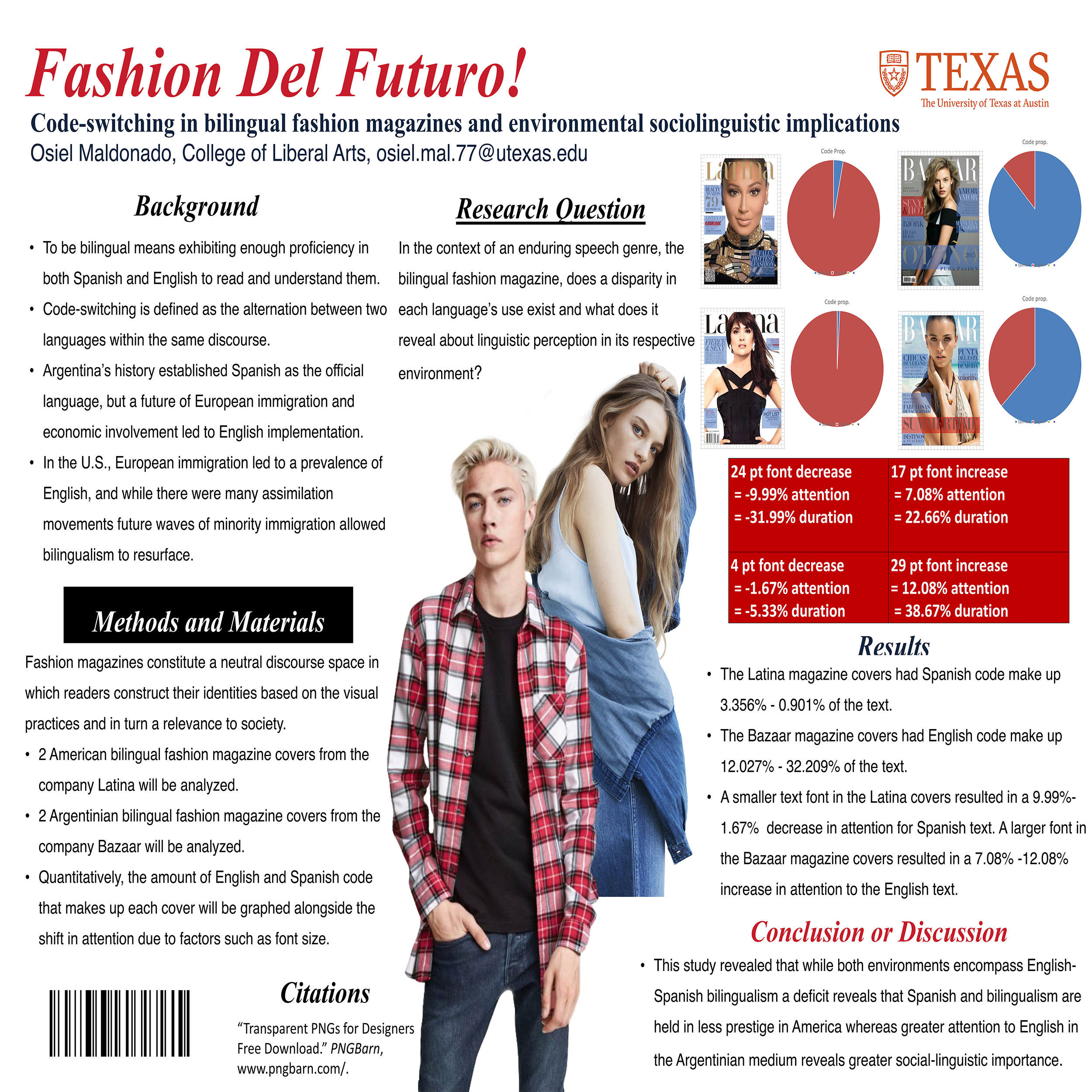Osiel Maldonado
Code-switching is defined as the alternation between two languages within the same discourse (Bullock & Toribio, 2009). While code-switching is a commonly studied bilingual phenomena (Dolitsky, 2000; Jacobson, 2001; Eastman 1992), little has been done on the use of mixed discourse within written media (McClure, 1995). The prevalence of code-switching in magazine advertisement has been shown to reflect societal sentiments on bilingualism and the inherent socioeconomic factors attributed to readers in their respective environments (Haarmann, 2009). This is reflected by a more constrained use of code-switching in the United States as compared to Argentina within press, media, and speech aimed at the same audiences (Mahootian, 2005; Porto, 2014). This study will analyze the covers of the Argentinian fashion magazine, Bazaar, and the American magazine, Latina, considering that both magazines cater to the same upper- middle-class bilingual demographic. By implementing advertising analysis techniques, this study will examine the inclination magazine covers display towards each language and correlate it with reader demographics. I predict a constrained use of code-switching in American fashion magazines will reveal a stricter take on bilingualism and an environment where English holds repute as the dominant language. In contrast, Bazaar’s more prevalent use of the English language in a primarily Spanish magazine may reflect an environment where the language may exhibit an additive nature and is actively encouraged. Each country’s history and current socioeconomic landscape dictates that varying languages are attributed their own societal values, thus within these two environments I expect the value Spanish and English carry to qualitatively and quantitatively display itself in accordance to a deficit in use of one or the other (Porto, 2014; Haarmann, 2009; Potowski, 2014).

Comments
I love your project, it’s so creative! What made you decide on the topic to research? – Jacqueline Santillana
Thank you for the support! I’m actually an English-Spanish bilingual myself and was exposed to the idea that this aspect was perceived differently in many other countries. Naturally, curiosity led me to further explore the idea of language perception through one of the more natural aspects of bilingualism, code-switching. I chose fashion magazines because they’re a textual form of corpora which provide a neutral form of discourse space in order to appeal to all readers. That, alongside the creativity that goes into presenting these languages via magazine covers which i strive to emulate in my own poster inspired by the cover style itself, using similar fonts and a minimalist color scheme. – Osiel Maldonado
This is a great topic! Really highlights the underlying linguistic ideologies at play. While English is promoted in Argentina, Spanish is often suppressed in the U.S., and this is evident in the language choice by these magazines. – Amalia Merino
Thank you! While i did want to quantitatively reveal each language’s use i also wanted to provide a little bit of qualitative insight on the reasoning behind the established perceptions based on each environment’s unique history. – Osiel Maldonado
This is a very interesting study. Having just moved to Texas from Argentina, there is definitely a prestige to being bilingual in Spanish and English due to the economic impacts. Could the research be expanded to discuss other factors as to why Argentina has a greater social-linguistic importance of bilingualism, opposed to the United States? Living in Argentina, many of the schools were bilingual, many in English, but there were others that focused on Italian, German, Hebrew, and Portuguese, could it be that multilingualism is more heavily stressed therefore held in with greater social-linguistic importance? – Megan Offsie
Most definitely! What i aimed to examine in my research was was the prevalence of bilingualism within each environment while focusing on English-Spanish relations. However, this could definitely be expanded to other languages and facets of interaction. In terms of other languages it makes sense that many of them would be European, besides English, and while i did discover that because multilingualism is held in greater regard it’s more prevalent, more research can be done on the idea you propose. I may hypothesize that its a socio-linguistic prestige and opportunities posed by being multilingual that allow and almost encourage all of those other languages to be taught. However, your proposal also brings up another excellent point of whether the existence of these languages and stress to learn them further elevates their socio-linguistic importance in feedback loop fashion. This is an intriguing observation and would definitely serve as a great basis for me to further my work. – Osiel Maldonado
What a great topic! I’m curious what it would look like when comparing this same type of media originating in another context, such as a contemporary environment other than Argentina, or the use of French as a prestige language in English-language media 100 years ago. Did anything in particular inspire the choice of Argentinian media? – Rob Reichle
Thank you so much for your support, i was actually inspired to perform and in-depth study on code-switching due to the extended use of the French language throughout the textual medium in the fashion industry in environments where little to no bilingual culture exists. As an English-Spanish bilingual myself i naturally gravitated towards the use of Spanish in our own English dominant environment. Additionally, with the textual medium being such a good reflection of neutral consumer habits, Argentina was a natural choice due to its history of economic European influence and Spanish-English bilingual culture in the fashion industry. – Osiel Maldonado

